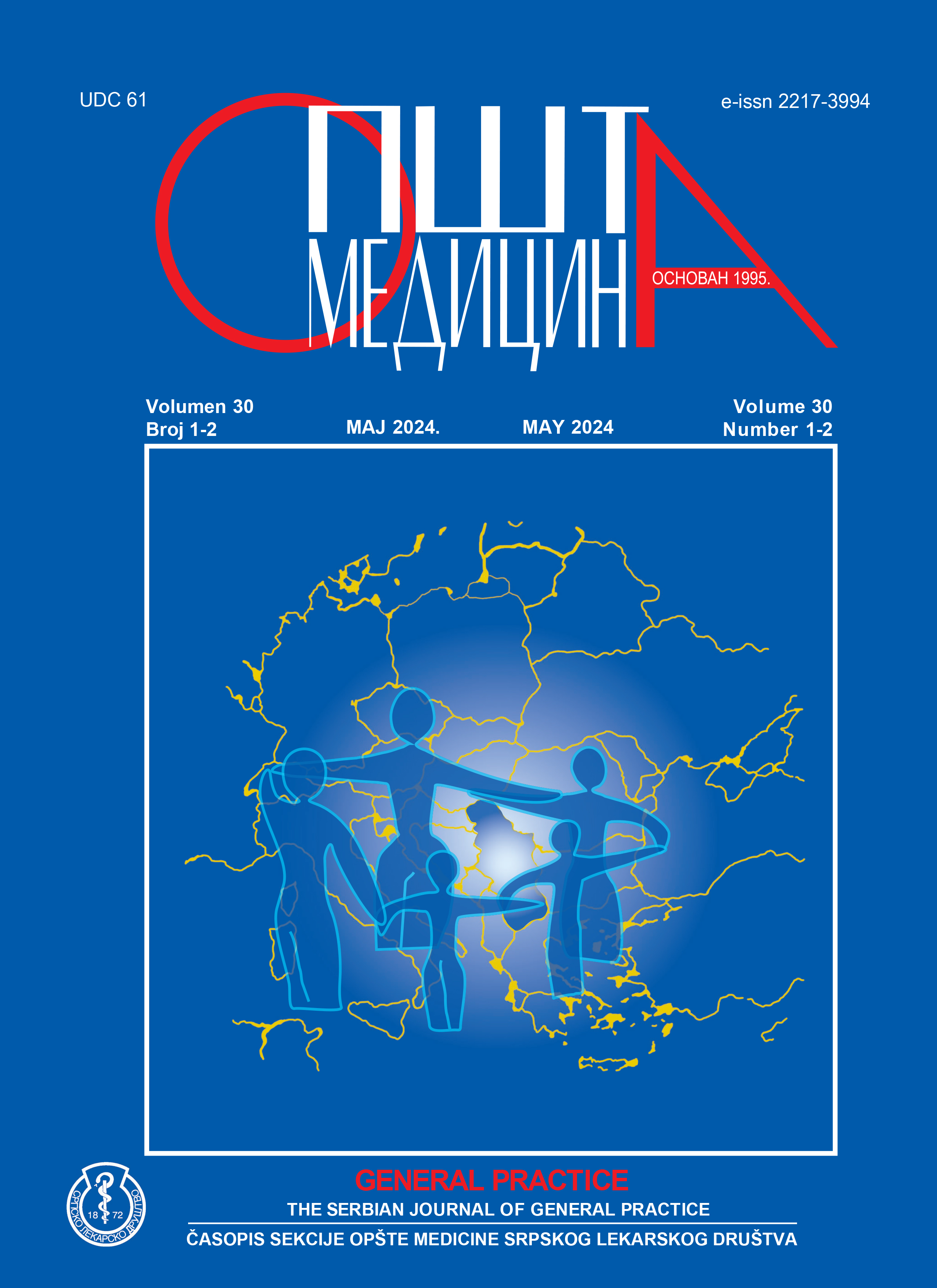Importance of ultrasonography in follow-up of multiple breast fibroadenomas
Abstract
Introduction: Regular ultrasonographic check-ups
help in early detection and follow-up of different diseases.
Ultrasonography (US) is of the utmost diagnostic importance
for mammographically „dense breasts“, where glandular tissue
is predominant, while in so-called „fat breasts“ it is less
reliable. It is used to determine the solid or cystic nature of
a lesion, often tissue characterization, and the Doppler technique
could reveal vascularization characteristics of the mass.
Fibroadenomas are the most common benign breast tumors
in women of all ages until menopause, with the highest incidence
between 15 and 25 years of age. The US detects distinctly
circumscribed, rarely round or lobular, hypoechoic
masses with smooth and flat contours, uniform echoes with
posterior augmentation, and marginal echo fading.
Case report: We presented a female patient aged 21,
who had multiple lesions in both breasts (25 lesions in total).
Ultrasonographic exams were performed multiple times,
in the last 5 years, and magnetic resonance (NMR) was done
twice. Histopathologic verification diagnosed fibroadenomas.
The biggest masses were surgically removed four times
in this patient. What are the next steps? Are surgical interventions
needed again, and if not how should she be followed up
in the future? Is the implant insertion eligible for the sake of
esthetic correction?
Conclusion: Ultrasonography is a very significant and
important method of follow-up of breast lesions. Mammography
and magnetic resonance are used as complementary
methods. According to a radiologist’s expert opinions on
breast diseases, ultrasonographic exams every six months
and NMR may indicate the need for surgical intervention,
especially if new
References
Oebisu N, Hoshi M, Ieguchi M, Takada J, Iwai T, Ohsawa M, et al. Contrast-enhanced color Doppler ultrasonography increases diagnostic accuracy for soft tissue tumors. Oncol Rep 2014;32(4):1654–60.
Geisel J, Raghu M, Hooley R. The Role of Ultrasound in Breast Cancer Screening: The Case for and against Ultrasound. Semin Ultrasound CT MR 2018;39(1):25–34.
Metcalfe SC, Evans JA. A study of the relationship between routine ultrasound quality assurance parameters and subjective operator image assessment. Br J Radiol 1992;65(775):570–5.
van Bodegraven EA, van Raaij JC, Van Goethem M, Tjalma WAA. Guidelines and recommendations for MRI in breast cancer follow-up: A review. Eur J Obstet Gynecol Reprod Biol 2017;218:5–11.
Stach A, Stubert J, Reimer T, Hartmann S. Benign breast disease in women. Dtsch Arztebl Int 2019;116(33-34):565–74.
Ajmal M, Khan M, Van Fossen K. Breast fibroadenoma. In: StatPearls [Internet]. Treasure Island (FL): StatPearls Publishing; 2023.
Salati SA. Breast fibroadenoma: a review in the light of current literature. Pol Przegl Chir 2020;93(1):40–8.
Lee M, Soltanian HT. Breast fibroadenoma in adolescents: current perspectives. Adolesc Health Med Ther 2015;6:159–63.
Nigro DM, Organ Jr CH. Fibroadenoma of the female breast. Some epidemiologic surprises. Postgraud Med 1976;59(5):113–7.
Krings G, Bean GR, Chen YY. Fibroepithelial lesions; The WHO spectrum. Semin Diagn Pathol 2017;34(5):438–52.
Li J, Humphreys K, Ho PJ, Eriksson M, Darai-Ramqvist E, Sofie Lindström L, et al. Family history, reproductive, and lifestyle risk factors for fibroadenoma and breast cancer. JNCI Cancer Spectr 2018;2(3):pky051.
Bhettani MK, Rehman M, Altaf HN, Ahmed SM, Tahir AA, Khan MS, et al. Correlation between body mass index andfibroadenoma. Cureus 2019;11(7):e5219.
Sanders LM, Sharma P, El Madany M, King AB, Goodman KS, Sanders AE. Clinical breast concerns in low-risk pediatric patients: practise review with proposed recommendations. Pediatr Radiol 2018;48(2):186–95.
Berg WA, Gutierrez L, NessAiver MS, Carter WB, Bhargavan M, Lewis RS, et al. Diagnostic accuracy of mammography, clinical examination, US, and MR imaging in preoperative assessment of breast cancer. Radiology 2004;233(3):830–49.
Kolb TM, Lichy J, Newhouse JH. Comparison of the performance of screening mammography, physical examination, and breast US and evaluation of factors that influence them: an analysis of 27,825 patient evaluations. Radiology 2002;225(1):165–75.
Camara O, Egbe A, Koch I, Herrmann J, Gajda M, Baltzer P, et al. Surgical management of multiple fibroadenoma of the breast: the ribeiro technique modified by Rezai. Anticancer Res 2009;29(7):2823–6.
Pasta V, Tintisona O, Vergine M, Martino G, Torcasio A, Palmieri A, et al. [Multiple repetitive mammary fibroadenomas. Case report]. G Chir 2007;28(5):209–12.
Povoski SP. The utilization of an ultrasound-guided 8-gauge vacuum-assisted breast biopsy system as an innovative approach to accomplishing complete eradication of multiple bilateral breast fibroadenomas. World J Surg Oncol 2007;Oct 29;5:124.
Dhar A, Srivastava A. Role of centchroman in regression of mastalgia and fibroadenoma. World J Surg 2007;31(6):1178–84.
Alipour S, Abedi M, Saberi M, Maleki-Hajiagha A, Faiz F, Shahsavari S, et al. Metformin as a one new option in the medical menagement of breast fibroadenoma; a randomized clinical trial. BMC Endocr Disord 2021;21(1):169.
Mashoori N, Assarian A, Zand S, Patocskai E. Recurrrent multiple fibroadenomas: History of a case presented in MDT meeting with clinical discussion and decision making. Arch Breast Cancer 2018;5(4):159–62.
Copyright (c) 2024 Snežana Stojanović Ristić, Branka Toljić

This work is licensed under a Creative Commons Attribution-NonCommercial-ShareAlike 4.0 International License.
Autori zadržavaju autorska prava nad objavljenim člancima, a izdavaču daju neekskluzivno pravo da članak objavi, da u slučaju daljeg korišćenja članka bude naveden kao njegov prvi izdavač, kao i da distribuira članak u svim oblicima i medijima.

